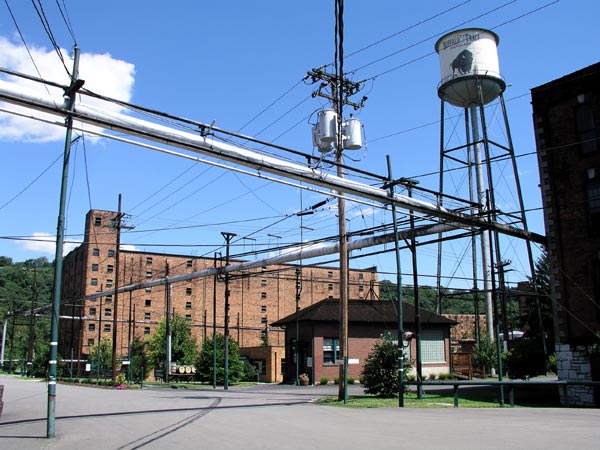
We don't know what it's for, but the pink building was nifty...

This is one of their warehouses.

On our way from Kentucky to Ohio, we decided we had time for one more distillery, so we stopped at the
Buffalo Trace distillery, which neither of us had ever heard of.
The grounds weren't as picturesque as some of the other distilleries, but the people were friendly, and we were just in time
to catch the next tour...

We don't know what it's for, but the pink building was nifty...

This is one of their warehouses.

We walked to this building with the tour group, for an introductory video and some equipment displays. Here's an old still:
"As the mighty buffalo thundered across the land, they carved paths in the wilderness and a destiny for our ancestors.
These paths, known as traces, were soon marked with the footprints of adventurers, explorers and pioneers as they made
their journey to the west."
"One such trace, called the Great Buffalo Trace, led to the rugged banks of what is now called the Kentucky River. It
was here in Franklin County, just a short distance from Kentucky's state capitol of today, that millions of buffalo
found passage across the river in their move toward the Great Plains. The migration of these herds left a rough wide clearing
that would become a gateway to a new frontier that invited renowned explorers and pioneers, such as George Rogers
Clark and legendary Daniel Boone, and countless settlers who pushed America westward more than 220 years ago."
"The McAfee brothers made the first survey of the crossing site and the surrounding area in 1773. A settlement came into
existence at the crossing in 1775, when brother Hancock and Willis Lee established their camp with a small company of men.
The group fought for survival in the unforgiving conditions of a fierce wilderness, but by 1789 the area held a thriving
population. Those who settled there were quick to take advantage of the abundant limestone spring water and fertile bottom
loam-found to be perfect for growing exceptional grain. Distillation soon followed and what would become the area's
distinguished bourbon heritage took root."
"The tradition of fine bourbon making has been a part of this site's heritage for more than two centuries. In fact,
there has been a working distillery on the grounds since 1787. The first modern distillery was built on this site in
1857 and was the first to incorporate the use of steam power - a major advance in producing high quality bourbon. The
distillery was later purchased by E.H. Taylor, Jr., one of Kentucky's original Bourbon aristocrats. Astute and
innovative, Taylor brought advancements to the facility as well as to the entire whiskey industry. By 1886, the
distillery had introduced the nation's first climate-controlled warehousing for aging whiskey and had earned a
worldwide reputation for producing America's finest bourbons."
"During the prohibition era, the distillery's existence was spared by the allowance of a permit - one of only four issued
in the country - to continue distillation for medicinal purposes. After Repeal, Albert Blanton took over the operation
of the distillery and added many quality control enhancements. An innovator in his own right, Blanton enjoyed producing
single-barrel bourbon for himself and his friends. This tradition was honored in 1984 when the distillery became the
first to commercially market a single-barrel bourbon."
"Today the Buffalo Trace Distillery site encompasses 110 acres and 110 buildings. Formerly the Leestown Company, the
distillery was renamed in June 1999 and introduced its flagship bourbon, Buffalo Trace Kentucky Straight Bourbon Whiskey,
in August 1999. In addition to Buffalo Trace Kentucky Straight Bourbon Whiskey, the distillery has a history of other
finely crafted, award-winning spirits, including Blanton's, Rock Hill Farms, Hancock's Reserve, and Eagle Rare. The
distillery has won more international awards since 1990 than any other North American distillery, earning more than
85 distinctions in national and international competitions."
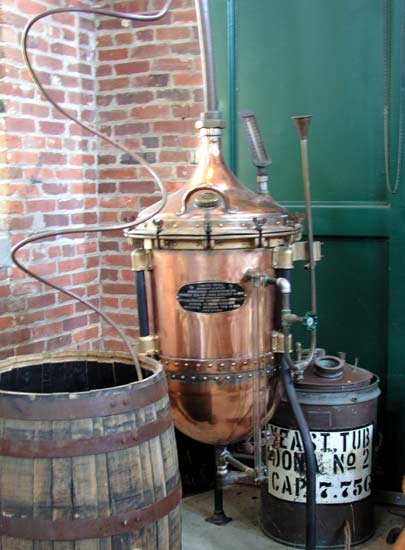
and quite a few barrels to illustrate how they are made and charred. See the
Woodford Reserve page for details on the process.
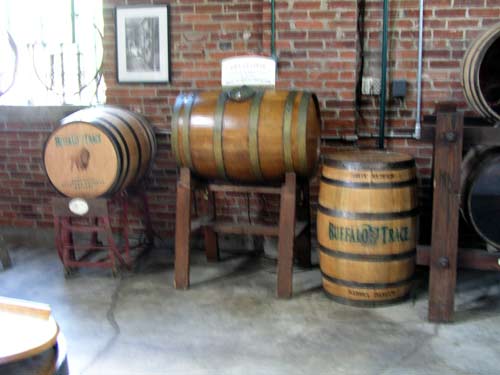
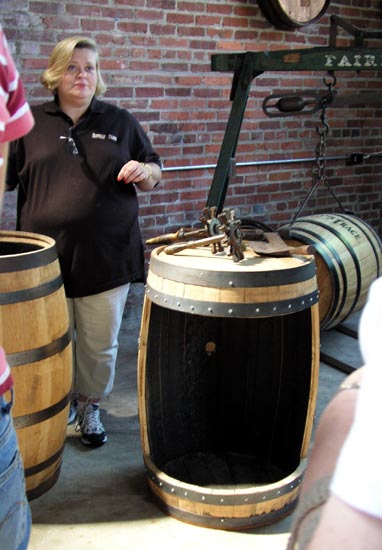
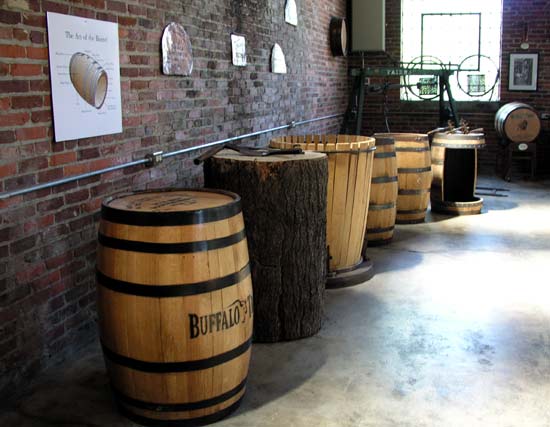
A little history from the Buffalo Trace web site:
The next stop was to see one of their warehouses.


"Buffalo Trace Distillery: Warehouse CSome distilleries are not so fond of heated warehouses, because they claim it is just done to speed up the aging process and enable mass production, but that it does not generate the same flavor as natural aging....of course, what flavor of whiskey is "better" is always a personal choice. On its web site, Buffalo Trace claims to be the first distillery to heat warehouses and the only distillery to produce its own vodka from scratch.
Built in 1881, this graceful whiskey aging warehouse is a fine example of "Rick Construction". The basic structure was built of massive wooden beams which bear the entire weight of 24,000 barrels residing herein. The foundation consists of Kentucky river marble, quarried from the Kentucky River, a short distance away. The 18-inch think brick walls allow our warehousemen to control the temperature within. The shuttered windows are open in the summer and closed in the winter so the perfect temperature balance is maintained and the barrels are allowed to age year-round. When the windows are open and the breeze is just right, you can smell the heavenly aroma of bourbon known as the "Angel's Share". "
Then, we visited one of their packaging buildings.
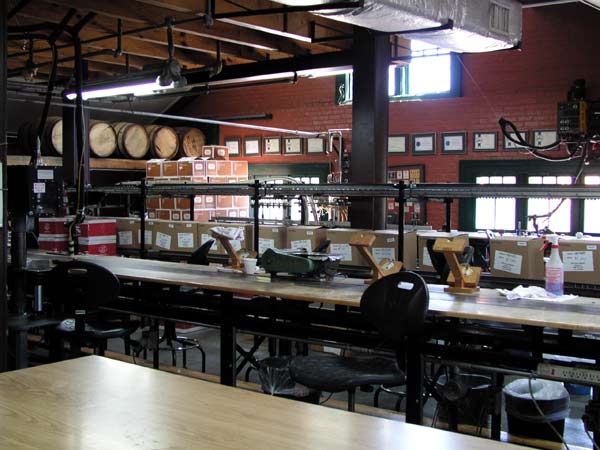
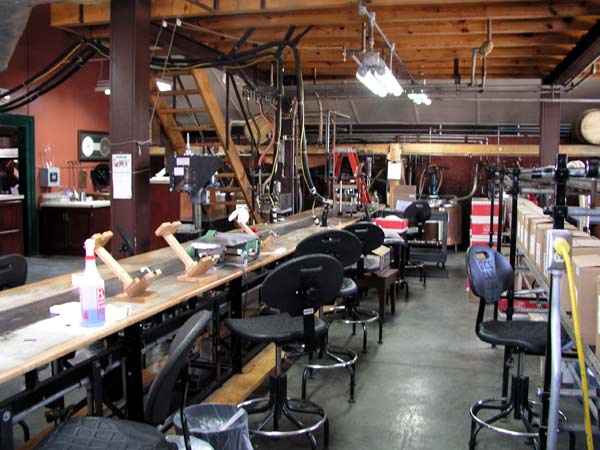
We liked their product display, and were intrigued by the "Rip Van Winkle" bourbon...
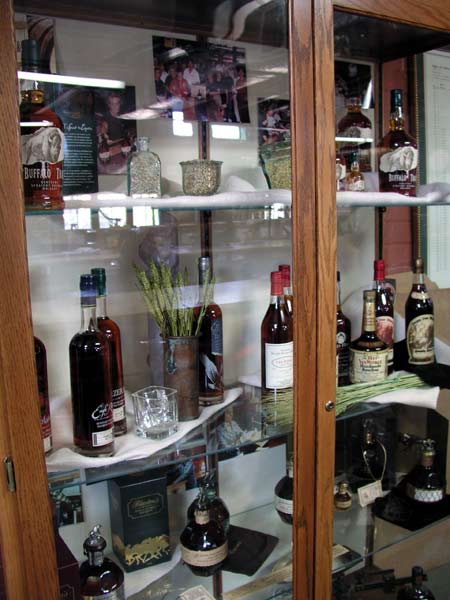
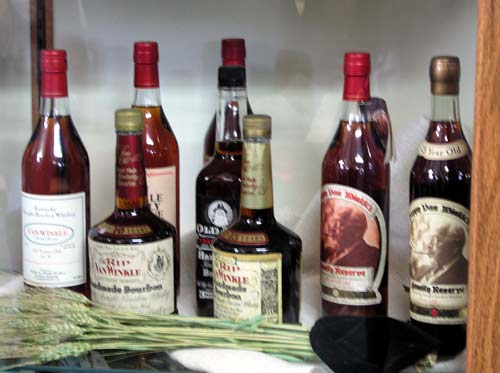
and Mike liked the mini-corks with race horses on top.

The final stop was their gift shop, where we were able to sample some of their products. Neither one of us cared
for their bourbon, but we did really like their Vodka.